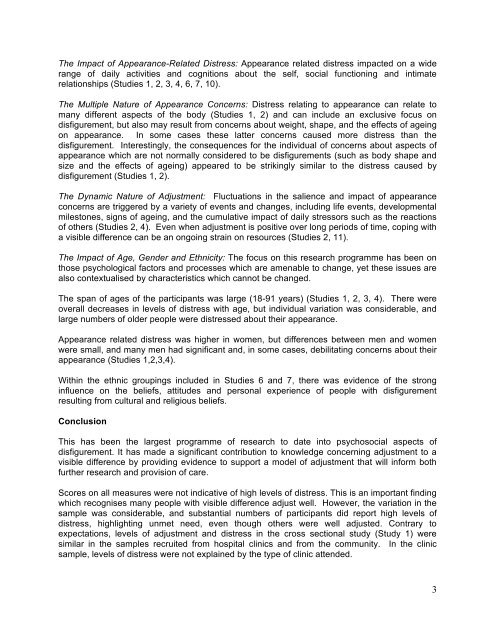Download the report - The Healing Foundation
Download the report - The Healing Foundation
Download the report - The Healing Foundation
You also want an ePaper? Increase the reach of your titles
YUMPU automatically turns print PDFs into web optimized ePapers that Google loves.
<strong>The</strong> Impact of Appearance-Related Distress: Appearance related distress impacted on a wide<br />
range of daily activities and cognitions about <strong>the</strong> self, social functioning and intimate<br />
relationships (Studies 1, 2, 3, 4, 6, 7, 10).<br />
<strong>The</strong> Multiple Nature of Appearance Concerns: Distress relating to appearance can relate to<br />
many different aspects of <strong>the</strong> body (Studies 1, 2) and can include an exclusive focus on<br />
disfigurement, but also may result from concerns about weight, shape, and <strong>the</strong> effects of ageing<br />
on appearance. In some cases <strong>the</strong>se latter concerns caused more distress than <strong>the</strong><br />
disfigurement. Interestingly, <strong>the</strong> consequences for <strong>the</strong> individual of concerns about aspects of<br />
appearance which are not normally considered to be disfigurements (such as body shape and<br />
size and <strong>the</strong> effects of ageing) appeared to be strikingly similar to <strong>the</strong> distress caused by<br />
disfigurement (Studies 1, 2).<br />
<strong>The</strong> Dynamic Nature of Adjustment: Fluctuations in <strong>the</strong> salience and impact of appearance<br />
concerns are triggered by a variety of events and changes, including life events, developmental<br />
milestones, signs of ageing, and <strong>the</strong> cumulative impact of daily stressors such as <strong>the</strong> reactions<br />
of o<strong>the</strong>rs (Studies 2, 4). Even when adjustment is positive over long periods of time, coping with<br />
a visible difference can be an ongoing strain on resources (Studies 2, 11).<br />
<strong>The</strong> Impact of Age, Gender and Ethnicity: <strong>The</strong> focus on this research programme has been on<br />
those psychological factors and processes which are amenable to change, yet <strong>the</strong>se issues are<br />
also contextualised by characteristics which cannot be changed.<br />
<strong>The</strong> span of ages of <strong>the</strong> participants was large (18-91 years) (Studies 1, 2, 3, 4). <strong>The</strong>re were<br />
overall decreases in levels of distress with age, but individual variation was considerable, and<br />
large numbers of older people were distressed about <strong>the</strong>ir appearance.<br />
Appearance related distress was higher in women, but differences between men and women<br />
were small, and many men had significant and, in some cases, debilitating concerns about <strong>the</strong>ir<br />
appearance (Studies 1,2,3,4).<br />
Within <strong>the</strong> ethnic groupings included in Studies 6 and 7, <strong>the</strong>re was evidence of <strong>the</strong> strong<br />
influence on <strong>the</strong> beliefs, attitudes and personal experience of people with disfigurement<br />
resulting from cultural and religious beliefs.<br />
Conclusion<br />
This has been <strong>the</strong> largest programme of research to date into psychosocial aspects of<br />
disfigurement. It has made a significant contribution to knowledge concerning adjustment to a<br />
visible difference by providing evidence to support a model of adjustment that will inform both<br />
fur<strong>the</strong>r research and provision of care.<br />
Scores on all measures were not indicative of high levels of distress. This is an important finding<br />
which recognises many people with visible difference adjust well. However, <strong>the</strong> variation in <strong>the</strong><br />
sample was considerable, and substantial numbers of participants did <strong>report</strong> high levels of<br />
distress, highlighting unmet need, even though o<strong>the</strong>rs were well adjusted. Contrary to<br />
expectations, levels of adjustment and distress in <strong>the</strong> cross sectional study (Study 1) were<br />
similar in <strong>the</strong> samples recruited from hospital clinics and from <strong>the</strong> community. In <strong>the</strong> clinic<br />
sample, levels of distress were not explained by <strong>the</strong> type of clinic attended.<br />
3


